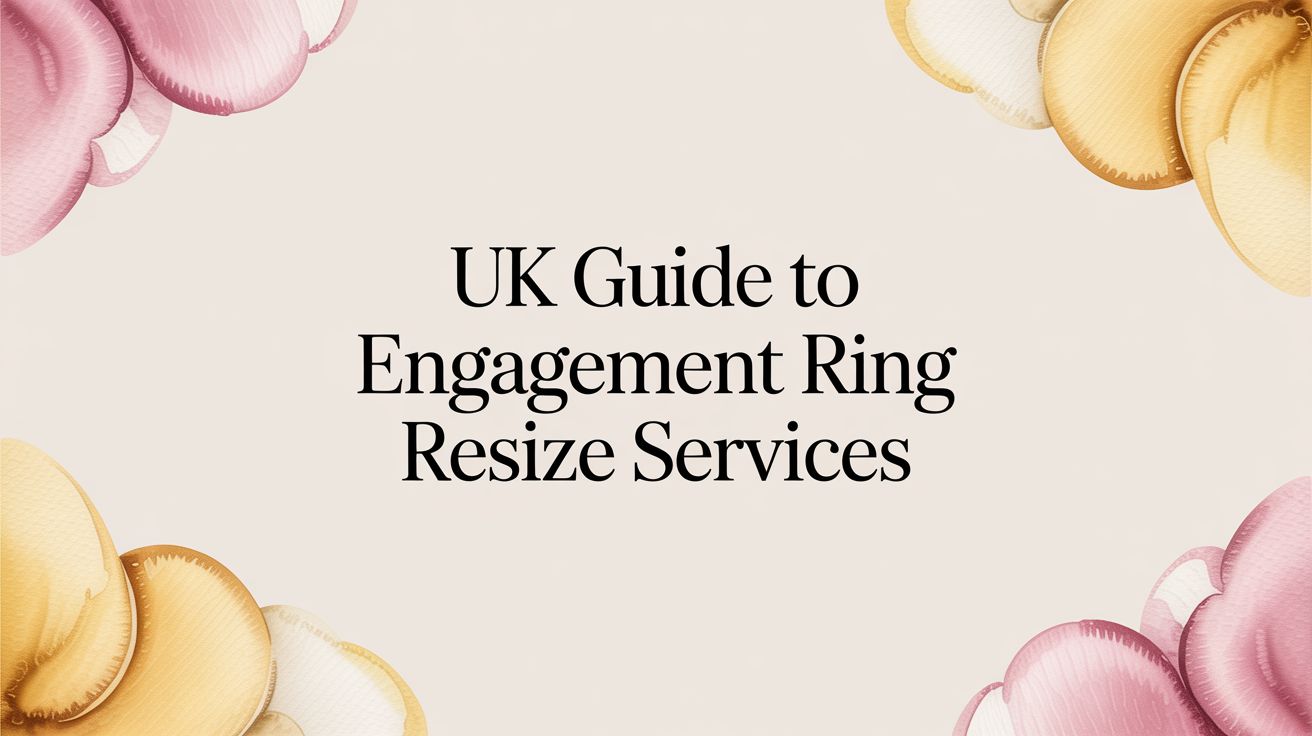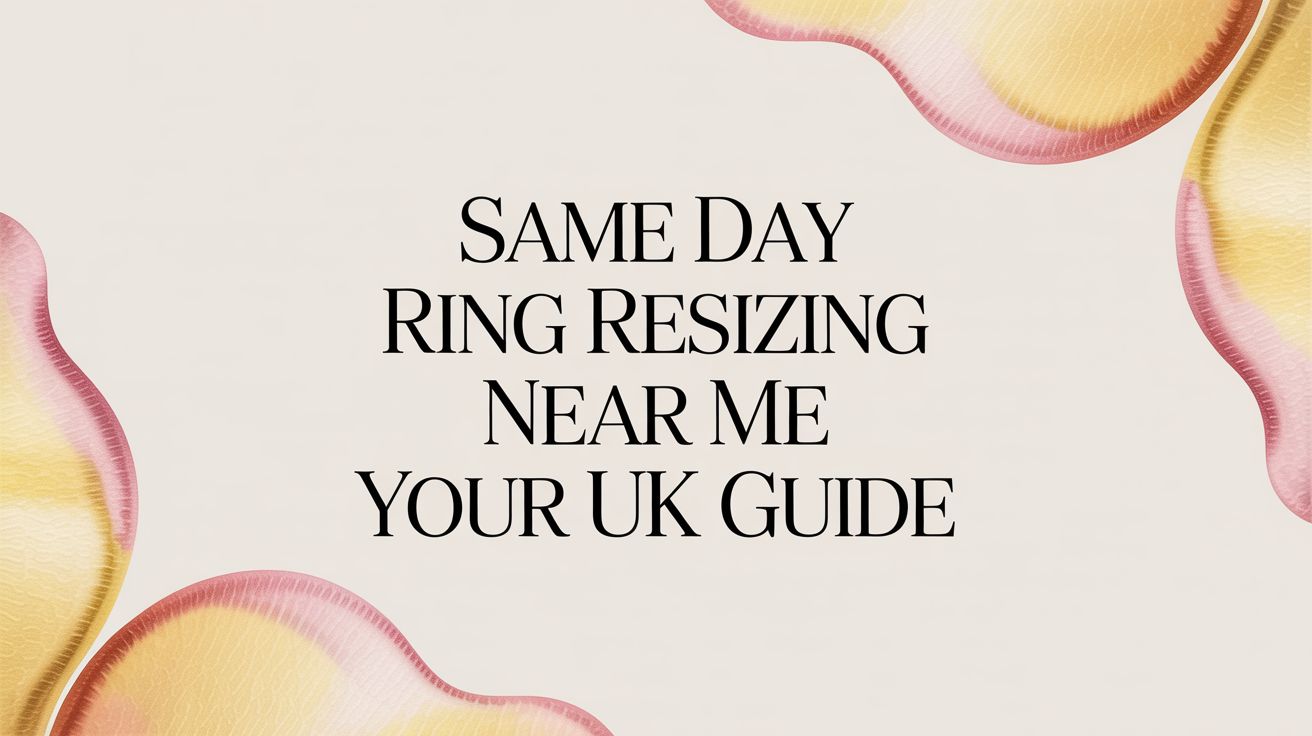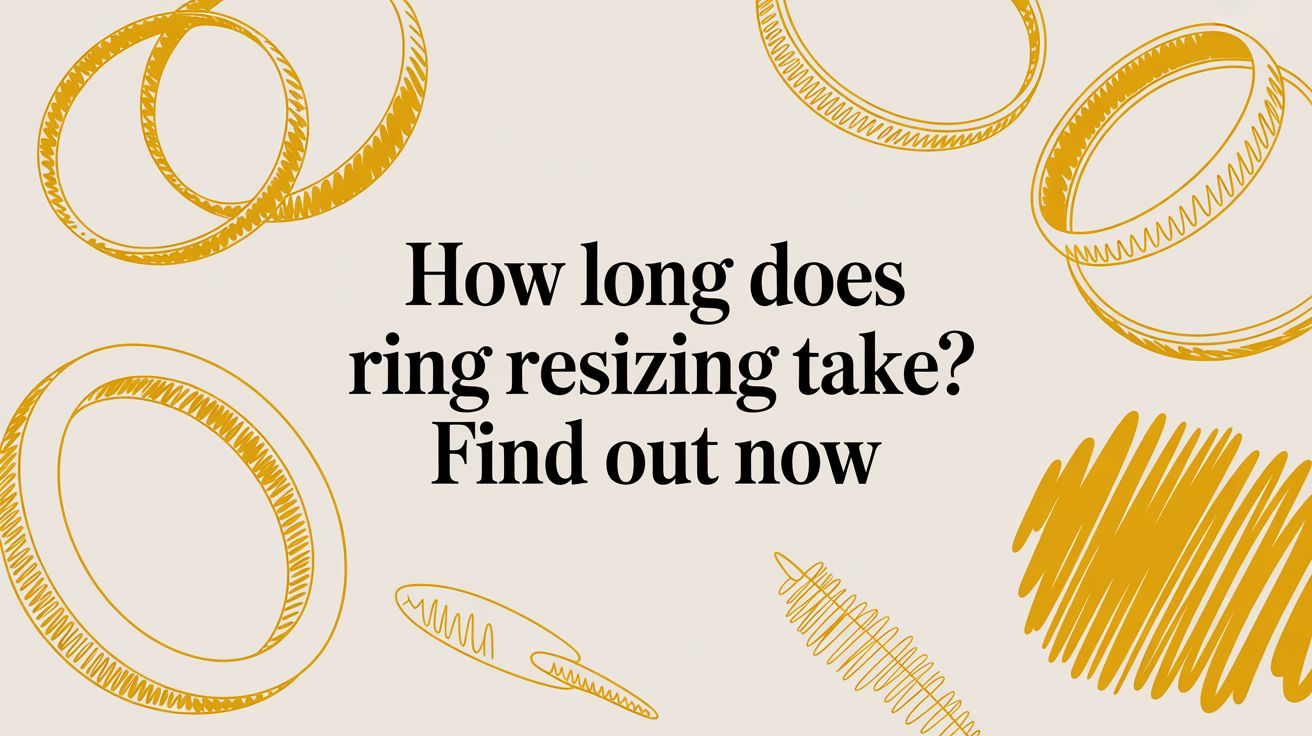That moment of panic is all too common: your beautiful new engagement ring is just a little too snug, or it spins frustratingly on your finger. Don't worry, this is a completely normal and very fixable situation. An engagement ring resize is a standard, straightforward procedure for any skilled jeweller, ensuring your treasured piece fits perfectly.
Why a Perfect Fit Matters for Your Engagement Ring
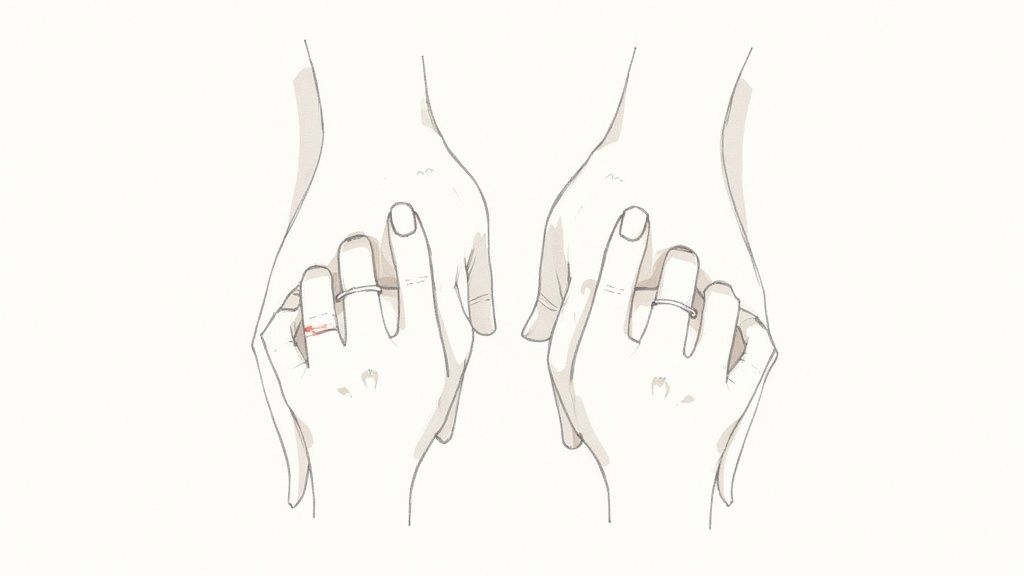
An engagement ring is more than just jewellery; it’s a symbol of love you wear every single day. So, how it fits is about more than just comfort—it’s about security, too.
A ring that's too loose is a constant worry, at risk of slipping off while you're washing your hands or pulling on a pair of gloves. On the other hand, one that’s too tight can be genuinely uncomfortable, sometimes even restricting circulation.
The thing is, our finger sizes aren't static. They can change with the weather, the time of day, or major life events. A ring that felt just right during a surprise proposal might feel completely different a few months down the line.
Understanding Ring Size Fluctuations
It’s completely normal for your finger size to vary slightly. A handful of factors contribute to this, making a resize a common necessity for many.
- Temperature and Humidity: Your fingers tend to swell in warm, humid weather and shrink back down when it's cold.
- Time of Day: Many people find their fingers are slightly larger in the evening compared to the morning.
- Lifestyle Changes: Events like pregnancy or significant changes in weight can definitely alter your ring size.
- Diet and Hydration: Eating salty foods or not drinking enough water can cause temporary swelling.
Because of these natural fluctuations, getting the fit spot-on is a delicate balance. The goal is a ring that slides over your knuckle with a little bit of resistance but then sits comfortably at the base of your finger without spinning around.
How Common Is Engagement Ring Resizing?
If you need to adjust your ring, you are far from alone. In the UK, the sizing system runs from A to Z+, and while the most common women’s ring size is an M, this standard measurement doesn't account for those daily physiological changes.
Industry experience and research both point to the same thing: a huge number of people—around 60% of women—will eventually need their ring resized. This often happens due to weight changes, pregnancy, or simply realising you need a more secure fit after wearing the ring for a while. You can discover more about the nuances of UK ring sizing and see why adjustments are so common.
A well-fitted engagement ring provides peace of mind. You should be able to wear it with confidence every day, knowing it’s both comfortable and secure. Don't settle for a fit that's just almost right.
Thinking about resizing? It helps to have a clear picture of what's involved from the start.
Quick Overview of Engagement Ring Resizing
| Consideration | Key Details |
|---|---|
| Sizing Up vs. Sizing Down | Sizing up requires adding metal; sizing down involves removing a small piece. |
| Metal Type | Gold, platinum, and silver are straightforward. Titanium and tungsten are difficult or impossible. |
| Ring Design | Plain bands are easiest. Eternity rings or complex settings require specialist assessment. |
| Typical Cost | Expect to pay between £50 and £150 for a standard resize, depending on metal and complexity. |
| Turnaround Time | Simple jobs can often be done the same day. Complex rings may take 24-48 hours or more. |
| Finding a Jeweller | Always choose a reputable goldsmith with experience in resizing fine jewellery. |
This table gives you a snapshot, but the specifics always come down to your individual ring and the jeweller's expertise.
Can Your Engagement Ring Actually Be Resized?
Before you start looking for a jeweller, the first question to ask is whether your ring is even a candidate for resizing. While most engagement rings can be adjusted with relative ease, certain metals and designs present real, sometimes insurmountable, challenges. Knowing what’s possible from the outset helps set realistic expectations.
The very first thing a goldsmith will look at is the metal itself. Precious metals like gold—whether it's yellow, white, or rose—and platinum are the most cooperative. They’re malleable enough for a skilled hand to cut, solder, and reshape them without compromising the ring’s integrity. They are designed to be worked with.
But not all metals are so forgiving. Some of the popular contemporary options are notoriously difficult, if not impossible, to alter.
- Titanium & Tungsten: These metals are incredibly hard and durable, which is great for daily wear but a nightmare for adjustments. Their high melting points and brittleness mean they generally cannot be resized at all.
- Stainless Steel: Much like titanium, stainless steel is simply too hard for traditional resizing techniques.
If your ring is made from one of these alternative metals, a standard resize is almost certainly off the table.
How Your Ring's Design Affects Resizing
Beyond the metal, the ring’s design plays a massive role. A simple, plain solitaire band is the most straightforward job, whether it needs to go up or down. As soon as you add intricate details, however, the process gets more complicated.
One of the most common hurdles is the eternity band. A full eternity ring, with diamonds or gemstones set continuously around the entire band, cannot be resized in the traditional way. Cutting the band would break the pattern and, more importantly, compromise the security of the stones. To adjust it would mean completely rebuilding the ring.
Similarly, rings with detailed engravings or intricate patterns along the shank pose a challenge. When a piece of metal is cut out or added in, it’s extremely difficult for a jeweller to perfectly replicate the original design. This can often leave a visible interruption where the work was done.
As a general rule of thumb, most rings can be safely adjusted up or down by about two sizes. Pushing beyond this limit risks weakening the band or distorting the setting that holds your main stone. A more significant change might need a more complex solution, like a new shank.
Gemstone and Setting Considerations
The type and arrangement of your gemstones are also key. While a single-stone solitaire is simple enough, other settings require a much more careful hand.
Pavé and Channel Settings: Rings with lots of small stones set closely together are particularly delicate. When the ring's curve is altered during resizing, the tension holding these tiny stones in place changes. This increases the risk of them becoming loose or even falling out. A reputable jeweller will always check and tighten every single stone after a resize, but it's a known risk with these designs.
Ultimately, the only way to know for sure is to have an expert physically inspect your ring. They can assess the metal, analyse the design’s intricacies, and check the security of your gemstones to give you a definitive answer and a plan for achieving that perfect fit.
The Jewellery Resizing Process Explained
Once your ring is safely with us, it’s not just a case of a quick snip and solder. Resizing is a meticulous blend of precision measurement and expert craftsmanship, all designed to change the fit without leaving a single trace.
It all starts with confirming the exact new size needed for a comfortable, secure fit. From there, the real bench work begins. The path your jeweller takes depends entirely on one simple question: does the ring need to go up or down in size? Each direction requires a totally different approach to get a flawless result while protecting the ring's structural integrity.
Making an Engagement Ring Smaller
If your ring is too loose, the process is thankfully quite direct. A skilled jeweller will carefully cut a small piece of metal from the bottom of the shank—that’s the part of the ring that sits underneath your finger. We always work here because it’s the least visible spot and is typically free of stones or complex patterns.
After removing the tiny segment, the two freshly cut ends are brought together. They are then soldered using a high-temperature torch, fusing them into a single, strong bond. The final, and arguably most crucial, stage is the finishing. The seam is carefully filed, sanded, and polished until the join becomes completely invisible, restoring the ring's perfect circular shape and smooth feel.
Making an Engagement Ring Larger
Making a ring bigger is a more complex task, and we have two primary methods to choose from. The right one depends on how much bigger the ring needs to be and its specific design.
- Stretching: For tiny adjustments, often just half a size, a jeweller might be able to gently stretch the metal using a specialised tool called a ring stretcher. It’s a quick method, but it can slightly thin the band. Because of the pressure involved, it's not suitable for rings with channel-set or pavé diamonds, as it can loosen the gems.
- Adding Metal: This is the more common and robust method. It involves cutting the shank and adding a new, perfectly matched piece of metal. The jeweller will insert a small bridge of gold or platinum, then solder it securely into place on both ends. This preserves the ring's original thickness and strength, making it the go-to technique for any significant size increase.
This infographic shows the key things a jeweller looks at before even touching the ring.
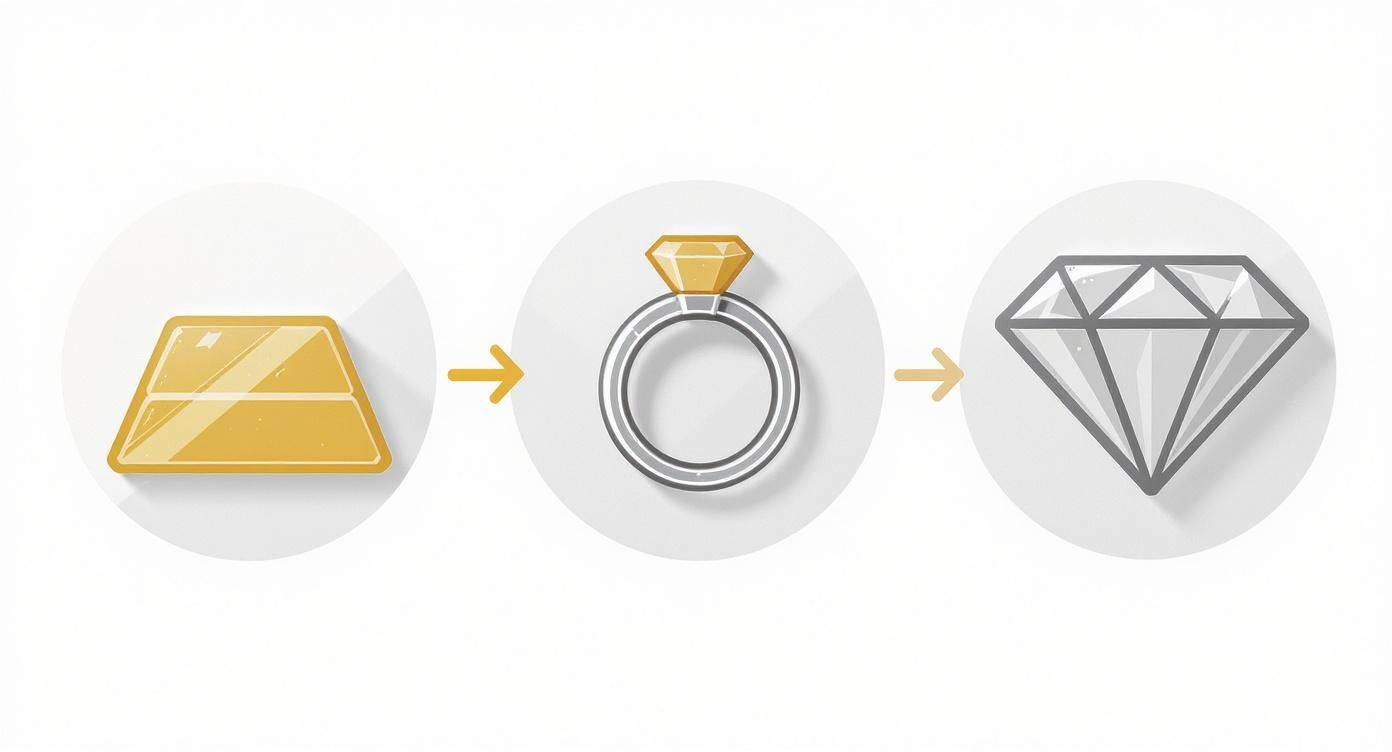
As you can see, the metal type, overall design, and how the stones are set are the three core factors that determine if and how an engagement ring resize can be done safely.
A professional jeweller’s ultimate goal is to make the alteration undetectable. When done correctly, there should be no visible seam, no discolouration, and no change to the ring's original beauty—only a perfect new fit.
The whole process, from consultation to final polish, requires an expert hand. Here in the UK, the timeline can vary. Sizing down a simple gold band might be done within a few hours or the next day. But a more complex job, like sizing up a platinum ring with diamond-set shoulders, will naturally take longer. To get a clearer idea of what to expect, you can find out more about how long ring resizing typically takes in our detailed guide.
How Much Does Ring Resizing Cost in the UK?
It’s the first question on everyone’s mind: what’s the damage? When it comes to resizing an engagement ring in the UK, you can generally expect a cost between £50 and £150 for a standard job. But that’s just a ballpark figure—the final price tag really depends on the ring itself.
Every ring is different, so the cost is never one-size-fits-all. The key factors are the metal, the complexity of the design, and whether we’re making it bigger or smaller. Sizing down a simple, plain gold band, for example, will always be at the lower end of that price range.
On the other hand, sizing up a platinum ring with diamond-set shoulders is a more involved process. The materials and highly skilled labour required naturally push the cost towards the higher end of the scale.
Factors That Determine Resizing Costs
The quote you get from a jeweller is based on a careful, hands-on assessment of your ring. One of the biggest rules of thumb? Making a ring larger nearly always costs more than making it smaller.
This is simply because sizing up requires us to add new precious metal. The cost of that gold or platinum has to be factored into the final price. Sizing down involves carefully removing a small piece of metal, so you’re primarily paying for the goldsmith’s time and expertise.
The metal type also plays a massive role in the final price.
- Gold and Silver: These are the workhorses of the jewellery world. They’re relatively malleable and straightforward to work with, keeping resizing costs down.
- Platinum: A completely different beast. Platinum has a much higher melting point than gold, demanding specialist laser-welding tools and more intensive labour, which bumps up the price.
With the average UK engagement ring costing between £1,800 and £2,500, it’s an investment worth protecting. Jewellers understand this, and the demand for a perfect, comfortable fit is huge.
Always ask for a detailed quote that breaks down the costs. A transparent jeweller will happily explain the charges for labour, materials, and any finishing touches like stone tightening or a final polish.
A clear breakdown means you know exactly what you’re paying for. For a more detailed look at what to expect for different jobs, our complete jewellery repair price list offers transparent pricing for a whole range of services, well beyond a simple resize.
Finding the Right Jeweller for Your Ring
An engagement ring is more than just jewellery; it’s a huge part of your story. So, the idea of leaving it with someone for an alteration can be nerve-wracking. Finding a craftsman you genuinely trust is the key to a flawless engagement ring resize. Don’t rush this part—the right person will make the adjustment look like it was never there.
The first thing I always recommend is to find a workshop with a goldsmith on-site. This is a big one. It means your ring stays in the building, which dramatically reduces the risk of it getting lost in transit and usually speeds up the whole process. Plus, you often get to speak directly to the person who’ll be working on your ring, which is brilliant for your peace of mind.
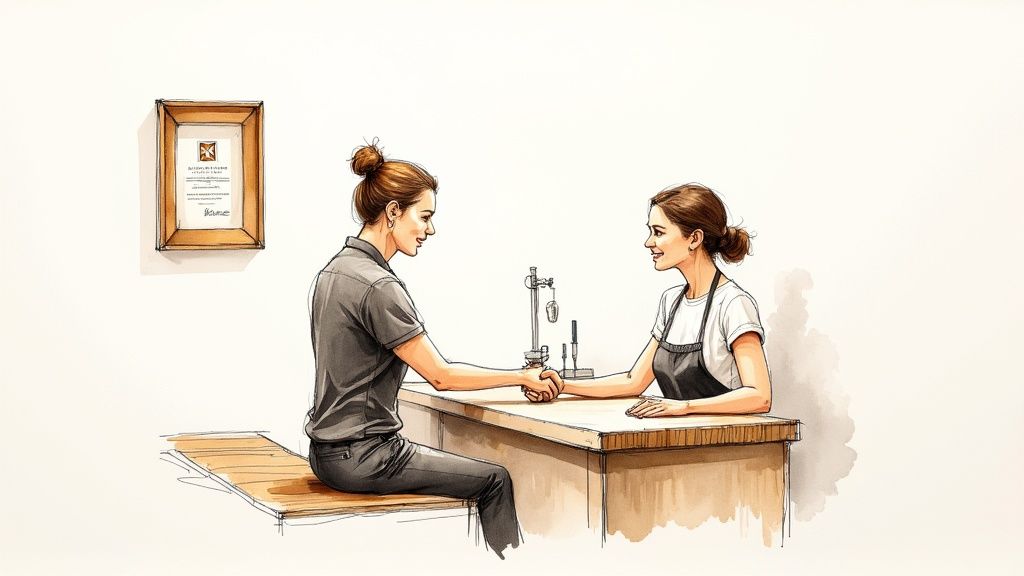
What to Look for in a Jeweller
Beyond just having a workshop, there are a few tell-tale signs of a true professional. Don't be shy about doing a bit of homework. Jump online and check out their reviews on Google or Trustpilot to see what other people’s experiences have been.
Look for a consistent pattern in the feedback. Are customers regularly mentioning the quality of the work, clear communication, and good service? These are all green flags. It's also worth checking for professional accreditations. Membership in a body like the National Association of Jewellers (NAJ) shows they’re committed to high ethical and professional standards.
Key Questions for Your Consultation
Once you have a shortlist, book a consultation. This is your opportunity to get a feel for their expertise and decide if you're comfortable leaving your ring in their hands.
Here are the essential questions I’d be asking:
- Have you resized rings like mine before? Show them the ring. Ask about their experience with similar metals, designs (like a pavé band or an unusual setting), and gemstones.
- What technique will you use? A good goldsmith will explain exactly how they plan to do it—whether they’ll stretch the band or, more likely, add or remove metal—and why that’s the best method for your specific ring.
- Do you guarantee your work? What happens if a stone becomes loose afterwards? Ask if their work is guaranteed and what their policy covers.
- What's the cost and how long will it take? Always get a clear, written quote before you agree to anything. A professional will be completely transparent about all the costs involved.
A trustworthy jeweller will be patient and thorough, taking the time to answer all your questions. You should feel confident in their ability, not pressured into making a quick decision.
Deciding between a high street chain and an independent workshop often comes down to what you value most. A big chain might be convenient, but an independent artisan often provides a more personal touch. For instance, a specialist workshop offering a ring resize in London will likely have you speaking directly with the goldsmith, ensuring every little detail is understood.
Ultimately, the most important thing is the proven skill and trustworthiness of the person handling your ring.
Expert Tips for a Perfect Fit the First Time
Getting an accurate finger measurement is the single best way to avoid needing an engagement ring resize down the line. It's not just about using a sizer; it’s about when you measure. Our fingers subtly swell and shrink throughout the day due to temperature and activity.
For the most reliable reading, measure your finger towards the end of the day when it's likely to be at its largest. It's also smart to avoid measuring right after a workout, when you're feeling particularly cold, or after a salty meal, as these conditions can give you a false reading.
Navigating Modern Ring Designs
The style of the ring itself plays a huge part in how it fits and the complexity of any future resizing. Understanding these little details can help you have a much better conversation with your jeweller and make an informed choice from the get-go.
For instance, UK jewellery trends have shifted towards slim, classic bands. Women’s rings now average just 2.2mm in width, and these delicate styles are estimated to make up 45% of engagement ring sales. The catch? Dainty bands are less forgiving of slight finger size changes, making a perfect fit even more crucial. You can see more about current UK engagement ring trends and how they affect sizing.
A key takeaway from any experienced goldsmith is this: wider bands often need you to go up half a size for comfort, while super-slim bands must be perfectly sized to stop them from spinning on your finger. Always talk about the band's width with your jeweller when finding your size.
Common Mistakes to Steer Clear Of
Even with the best intentions, a few common slip-ups can lead you right back to the jeweller’s workshop. Dodging these pitfalls will save you time, money, and a bit of stress.
One of the biggest culprits is guessing a partner's size for a surprise proposal. It's a lovely thought, but it’s a gamble. If you have to keep it a secret, try to discreetly borrow a ring they already wear on the correct finger, or ask a trusted friend for help.
It’s also crucial to avoid resizing a ring too many times. Every time a ring is cut, soldered, and reshaped, the metal is put under stress. Doing this repeatedly can weaken its structure over time, making it more prone to damage. The goal is to get it right the first time and stick to that size if you can.
At Opulence Jewellery Services, our master goldsmiths combine decades of hands-on experience with state-of-the-art tools to deliver a perfect, invisible fit. Visit our Hatton Garden workshop for a same-day consultation and expert resizing service. Learn more at https://www.opulencejewelleryservices.co.uk.
